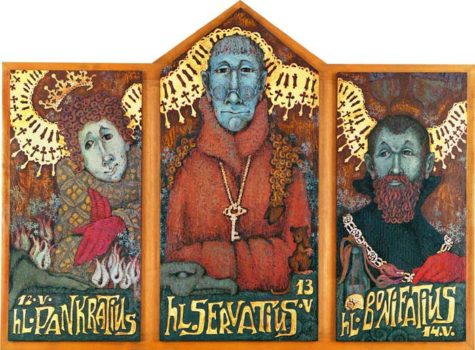May 11, 12, and 13 are the feast days of Saints Mamertus, Pancras, and Gervais. These three are known as the Three Chilly Saints not because they were cold during their lifetimes, but because these days bring a brief spell of colder weather in many years, including the last nightly frosts of the spring, and are traditionally the coldest of the month.
English and French folklore (and later American) held that these days would bring a late frost. In Germany, they were called the Icemanner, or Icemen Days, and people believed it was never safe to plant until the Icemen were gone. Another bit of folklore claimed:
“Who shears his sheep before St. Gervatius’s Day loves more his wool than his sheep.”
In Sweden, the German legend of the ice saints has resulted in the belief that there are special “iron nights,” especially in the middle of June, which are susceptible to frost. The term “iron nights” (järnnätter) has probably arisen through a mistranslated German source, where the term “Eismänner” (ice men) was read as “Eisenmänner” (iron men) and their nights then termed “iron nights,” which then became shifted from May to June.
To the Poles, the trio are known collectively as zimni ogrodnicy (cold gardeners), and are followed by zimna Zośka (cold Sophias) on the feast day of St. Sophia which falls on May 15. In Czech, the three saints are collectively referred to as “ledoví muži” (ice-men or icy men), and Sophia is known as “Žofie, ledová žena” (Sophia, the ice-woman).
Alternative Saints:
St. Mamertus is not counted among the Ice Saints in certain countries (Southern Germany, Austria, Northern Italy, Czech Republic, etc.), whereas St. Boniface of Tarsus belongs to them in other countries (Flanders, Liguria, Czech Republic etc.) as well; St. Boniface’s feast day falling on May 14. St. Sophia, nicknamed Cold Sophia (German kalte Sophie) on May 15 can be added in Germany, Alsace (France). In Poland and the Czech Republic, the Ice Saints are St. Pancras, Saint Servatus and St. Boniface of Tarsus.
Related Content:
- A nice little spell, Ice Saint Toxic People Banishing Spell, can be found at The Book of Shadows
Note:
The introduction of the Gregorian Calendar in 1582 involved skipping 10 days in the calendar, so that the equivalent days from the climatic point of view became May 22–25.
Found at: Almanac.com and wikipedia
Krazelna: Day of Hekate
Krazelna: Day of Hekate
Krazelna: Day of Hekate
Rachel V Perry: Emancipation Day
Rachel: The Nemesia




Leave a Reply